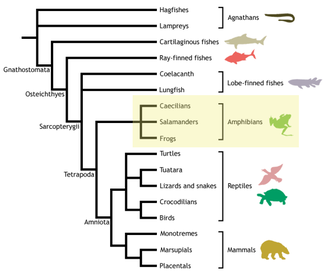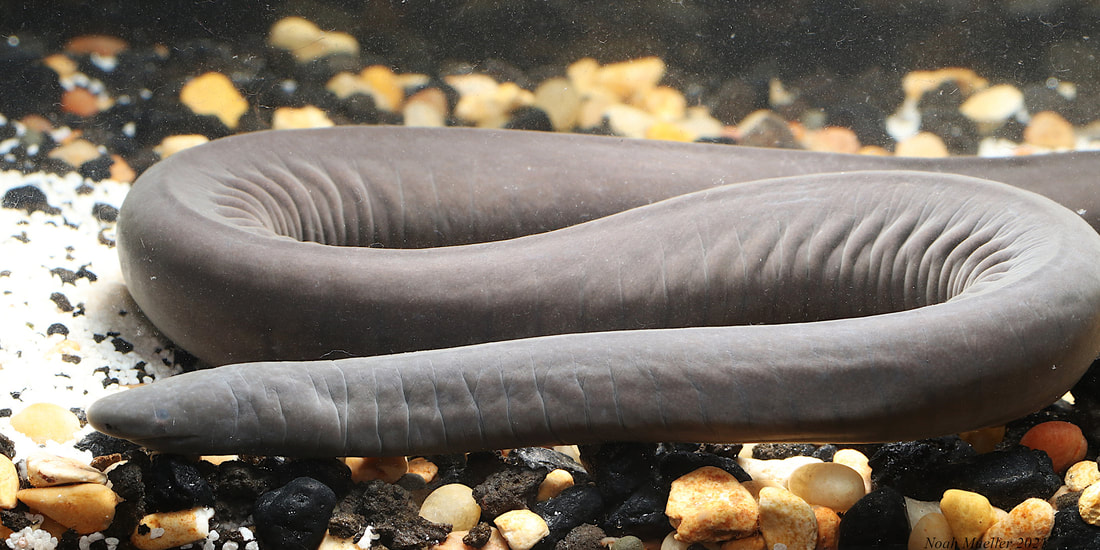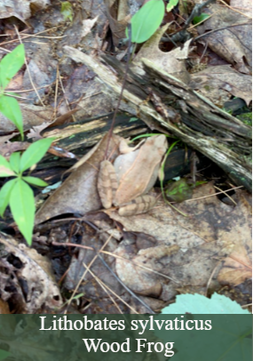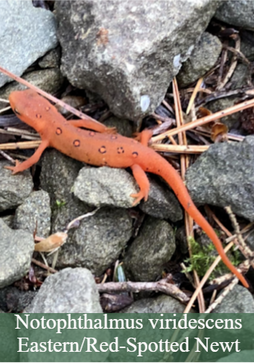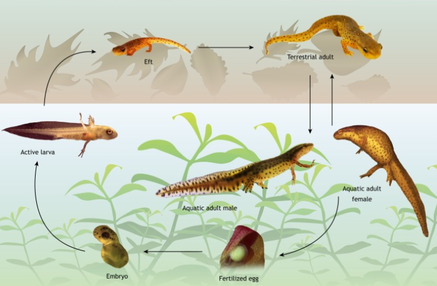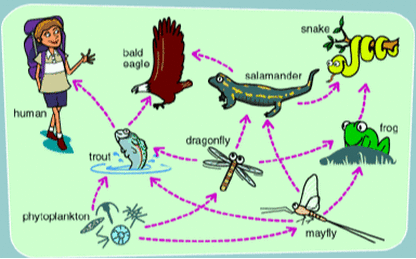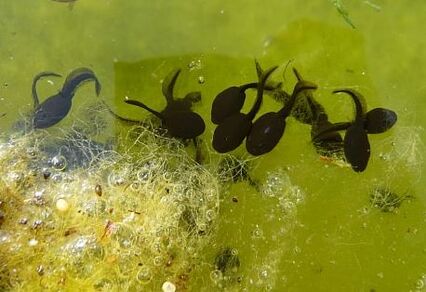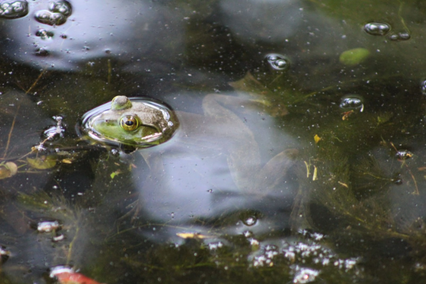What Are Amphibians?
|
What Makes An Amphibian an Amphibian?
How did Amphibians Come to Be? - The Evolutionary History of Amphibia.
Amphibians are a unique group of tetrapods ("four-footed" organisms). Four groups of vertebrates (organisms with an internal skeleton of cartilage and bone with a backbone) comprise tetrapods: amphibians, birds, reptiles, and mammals. The earliest tetrapods are estimated to be 390-360 million years old when lobed-finned fishes evolved, resulting in limbs and later, more adaptations for land. Currently, the need for limbs is thought to have occurred to help tetrapods stalk prey or to help them breathe air when in shallower waters. What Kind of Amphibians Exist Today?
Today's amphibians are classified into three major groups:
|
To learn more about the evolution of land animals or tetrapod origins, check out the video above published by PBS Eons!
This cladogram depicts the relatedness of other vertebrates to amphibians which stem from a common ancestor of the lobe-finned fishes.
This tree was provided by UCL staff at this link: https://www.ucl.ac.uk/museums-static/obl4he/vertebratediversity/index.html Typhlonectes natans is the first fully aquatic caecilian to be found in North America. Image taken by: Noah Mueller.
|
Common Amphibians at Lacawac Sanctuary
More Than Just the Newts!
Although the Eastern Newts may be the most abundant and easy to spot on a damp day, there are a number of different frog, toad, and salamander species that you can find in Lake Lacawac or nearby!
Masters of Disguise and Warning Signs
|
Photo Taken by: Chris Michael
|
Some amphibians are brightly colored to ward off predators and usually indicate they are poisonous! For example, young Eastern Newts (right) are brightly colored to indicate they secrete toxic chemicals. These newts keep the brightly colored red spots at nearly all life stages to warn predators like fish that they are poisonous.
Other amphibians have a different predator evasion strategy: camouflage. Some frogs have developed coloration to help them blend in with their surroundings, like the wood frog (right). |
Photo taken by: Lacawac intern
|
Life Cycle of Amphibia
Although some amphibians can be found in deserts and even in coastal areas, most are dependent on freshwater environments like wetlands, lakes, streams, and rivers for most if not all of their life. This makes amphibians fully aquatic or semi-aquatic, with unique adaptations to best suit their environment. Most amphibians hatch in an aquatic environment like many species of frog, and have a fully aquatic larval stage, like the tadpole. Tadpoles have gills to help them breathe underwater and a strong tail; however, adult frogs lose their tail and gills and grow four limbs to hop on land as well as develop lungs. This process is called metamorphosis. The term amphibians comes from the word amphibios, meaning "double life" in Greek. This "double life" refers to their time spent in water as juveniles, followed by adult life on land. Metamorphosis in frogs and other amphibians highlights the transition between the juvenile and adult stages and can occur in as little as one day! Unlike most amphibians, the Eastern Newt actually return to water as an adult rather than living completely terrestrially.
This diagram shows the life cycle of the Eastern Newt (Joven et al., 2019), an abundant newt on Lacawac Property. |
Above is the short film, "Becoming" by Jan van IJken showing a time-lapse of the development of Ichthyosaura alpestris, the alpine newt from embryo to larval stage. This film was published by National Geographic. |
Ecological and Scientific Importance
|
Amphibians play a key role in ecosystems as both predator and prey; many are carnivorous or insectivorous in nature, feeding on bugs like mosquitoes, slugs, spiders, or worms and even small vertebrates like birds, rodents, other amphibians, and even fish if aquatic (depending on their size!). In earlier stages of their life, such as tadpole stages, many have an herbivorous diet and feed on algal populations. By controlling and limiting algal populations through tadpole feeding, amphibians contribute greatly to the health of their freshwater system. When algae or other food sources are scarce, tadpoles may feed on one another to survive.
Being able to breathe through their skin makes amphibians extremely susceptible to disease and infection as well as extremely sensitive to chemicals, pollutants, and other contaminants that way find their way into habitats, such as lakes and water sources. This is because they directly absorb whatever is in the water rather than drinking or eating it like other animals. Bodies of water may be contaminated from runoff that comes from cities, industry, or agriculture that will feed into freshwater systems or they can be polluted from human usage. With such sensitivity to possible toxins in water, scientists may utilize them to assess water pollution, water quality, and the health of a freshwater body. Besides contaminants, amphibians are also highly sensitive to changes in climate, particularly droughts, excessive sun, and wind that may damage or dehydrate amphibians. Scientists may also utilize or study amphibians to assess how changes in climate may impact or explain declines in amphibian populations or other populations that are dependent on amphibians. In these regards, amphibians are considered bioindicators and may be used for biomonitoring. For more information on these terms, visit the Bioindicator page or continue walking this trail until you reach the QR! |
An example of a simple food web and where amphibians land in this food web.
Figure from Food Web page on Acid Rain Students' Site created by the United States EPA at: https://www3.epa.gov/acidrain/education/site_students/foodweb.html Image of tadpoles feeding on algae.
Photo taken by photographer on flickr: Ricardo and found athttps://pondinformer.com/what-to-feed-tadpoles/ Image of Lithobates catesbeianus, American Bullfrog, at Heron Pond.
Photo taken by: Camden Brewer |
Declination of Amphibians Worldwide: Threats of Disease, Pollution, and Habitat Loss
Populations of amphibians are declining worldwide primarily due to disease, habitat loss, and pollution. To learn more, check out this brief video published by the National Science Foundation!
References:
All About Amphibians. Burke Museum. https://www.burkemuseum.org/collections-and-research/biology/herpetology/all-about-amphibians/all-about-amphibians
Amphibian Pictures & Facts. National Geographic. https://www.nationalgeographic.com/animals/amphibians
Amphibians. Exploring Our Fluid Earth. https://manoa.hawaii.edu/exploringourfluidearth/biological/amphibians-reptiles-and-birds/amphibians-0
Eastern Newt. Smithsonian's National Zoo & Conservation Biology Institute. https://nationalzoo.si.edu/animals/eastern-newt#:~:text=Generally%2C%20efts%20metamorphose%20into%20aquatic,newts%2C%20have%20also%20been%20reported
Eastern Red-spotted Newt. Wildlife in Connecticut. https://portal.ct.gov/-/media/DEEP/wildlife/pdf_files/outreach/fact_sheets/RSNewtpdf.pdf
Maloles, J. (2020, December 10). The amazing life cycle of the red-spotted Newt. Credit Valley Conservation. https://cvc.ca/conservations/the-transforming-life-cycle-of-red-spotted-newt/
Marion, Z. H., & Hay, M. E. (2011). Chemical Defense of the eastern newt (notophthalmus viridescens): Variation in efficiency against different consumers and in different habitats. PLoS ONE, 6(12). https://doi.org/10.1371/journal.pone.0027581
Metamorphosis- amphibians. JRanks Articles. https://science.jrank.org/pages/4276/Metamorphosis-Amphibians.html
Species Profile: Red-spotted Newt (Notphthalmus viridescens). Savannah River Ecology Laboratory University of Georgia. https://srelherp.uga.edu/salamanders/notvir.htm
Team, B. How does camouflage protect a frog? https://animals.mom.com/camouflage-protect-frog-4972.html
The Importance of Amphibians. ARMI. https://armi.usgs.gov/importance-of-amphibians.php#:~:text=The%20Importance%20of%20Amphibians&text=They%20eat%20insect%20pests%20which,exceptional%20indicators%20of%20ecosystem%20health
Traits of reptiles and Amphibians. Savannah River Ecology Laboratory Universtiy of Georgia. http://archive-srel.uga.edu/outreach/factsheet/traits.html
Information compiled by Alexandra Bros and Camden Brewer. 2022.
Amphibian Pictures & Facts. National Geographic. https://www.nationalgeographic.com/animals/amphibians
Amphibians. Exploring Our Fluid Earth. https://manoa.hawaii.edu/exploringourfluidearth/biological/amphibians-reptiles-and-birds/amphibians-0
Eastern Newt. Smithsonian's National Zoo & Conservation Biology Institute. https://nationalzoo.si.edu/animals/eastern-newt#:~:text=Generally%2C%20efts%20metamorphose%20into%20aquatic,newts%2C%20have%20also%20been%20reported
Eastern Red-spotted Newt. Wildlife in Connecticut. https://portal.ct.gov/-/media/DEEP/wildlife/pdf_files/outreach/fact_sheets/RSNewtpdf.pdf
Maloles, J. (2020, December 10). The amazing life cycle of the red-spotted Newt. Credit Valley Conservation. https://cvc.ca/conservations/the-transforming-life-cycle-of-red-spotted-newt/
Marion, Z. H., & Hay, M. E. (2011). Chemical Defense of the eastern newt (notophthalmus viridescens): Variation in efficiency against different consumers and in different habitats. PLoS ONE, 6(12). https://doi.org/10.1371/journal.pone.0027581
Metamorphosis- amphibians. JRanks Articles. https://science.jrank.org/pages/4276/Metamorphosis-Amphibians.html
Species Profile: Red-spotted Newt (Notphthalmus viridescens). Savannah River Ecology Laboratory University of Georgia. https://srelherp.uga.edu/salamanders/notvir.htm
Team, B. How does camouflage protect a frog? https://animals.mom.com/camouflage-protect-frog-4972.html
The Importance of Amphibians. ARMI. https://armi.usgs.gov/importance-of-amphibians.php#:~:text=The%20Importance%20of%20Amphibians&text=They%20eat%20insect%20pests%20which,exceptional%20indicators%20of%20ecosystem%20health
Traits of reptiles and Amphibians. Savannah River Ecology Laboratory Universtiy of Georgia. http://archive-srel.uga.edu/outreach/factsheet/traits.html
Information compiled by Alexandra Bros and Camden Brewer. 2022.
Location |
|
